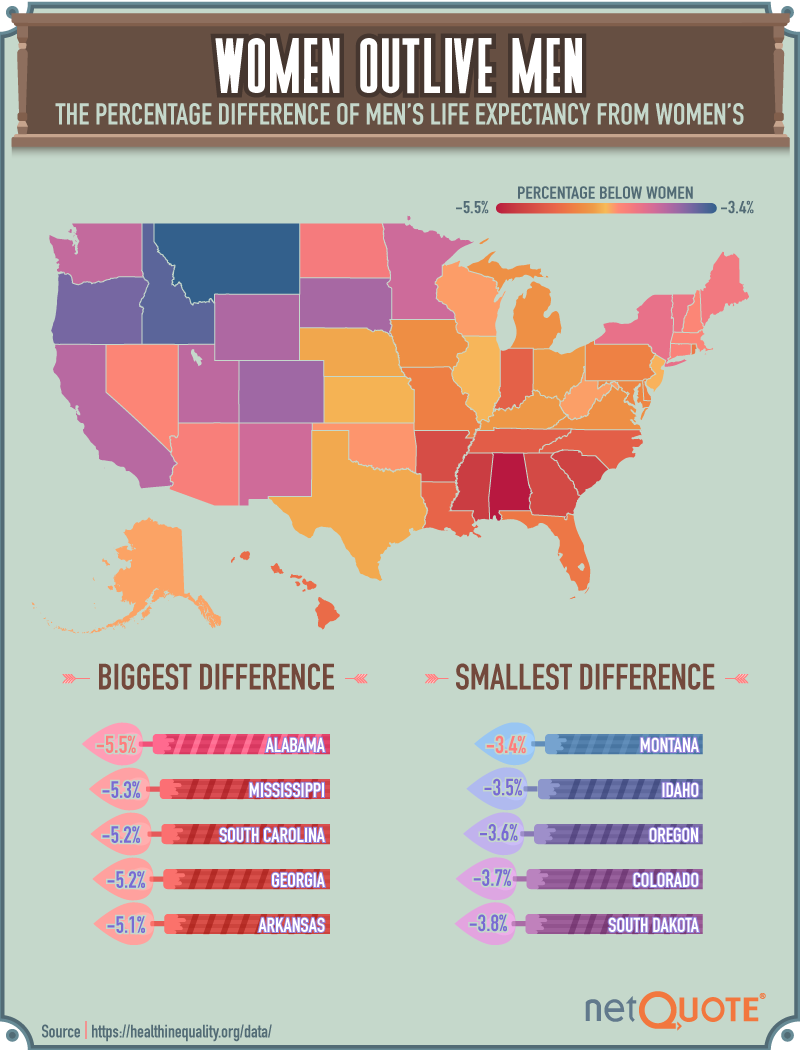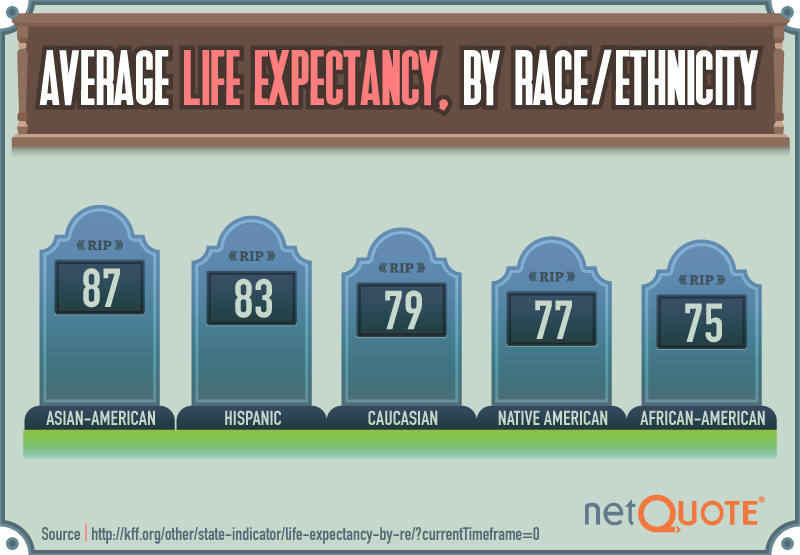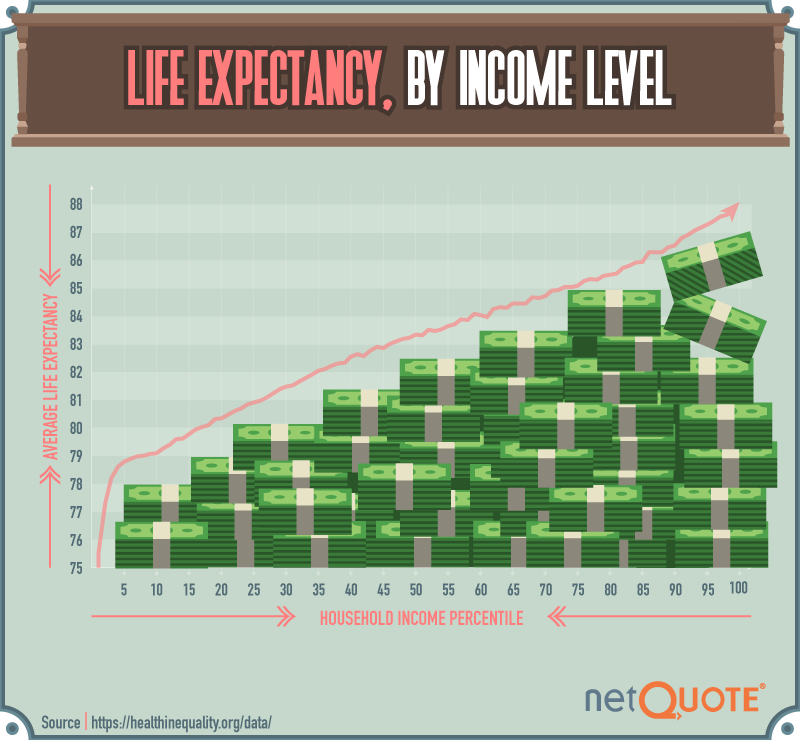Your Average Life Expectancy

The United States ranks 42nd in the world for average life expectancy (just under 80 years), according to the CIA.
However, people from Germany, Switzerland, and Japan tend to live longer — nearly 81 years, almost 83 years, and 85 years, respectively. When it comes to how many years any of us will live, there are several factors to consider. From race, gender and where we live, to how much money we make, life expectancy can fluctuate significantly.
We wanted to see just how life expectancy fluctuates in the United States between not only men and women but among different races and ethnicities. Curious to see your average life expectancy based on your unique characteristics? Keep reading to find out.
Estimate Your Average Life Expectancy
The number of years you have on this planet can fluctuate by several years or more based on your life circumstances.
Use our interactive calculator to see your average life expectancy based on your personal traits. You can even compare your average life expectancy with others around the world.
The Average Life Expectancy Between Men and Women

While researchers have long extrapolated the reasons women seem to outlive men, this gender gap continues to persist across the country.
Based on the data, Alabama, Mississippi, South Carolina, Georgia and Arkansas had the widest gap in the nation between men’s and women’s average life expectancy. In fact, the largest gap — found in Alabama — was nearly 6 percent. Unfortunately, this might have to do with the fact that Alabama has the second highest adult obesity rate in the nation and is ranked 46th for poverty. As we’ll continue to explore, income level can be a tremendous factor in prolonging one’s life expectancy.
On the other side of the spectrum, Montana, Idaho, and Oregon, Colorado and South Dakota had the smallest gap between men’s and women’s life expectancy — just under 4 percent.
The Average Life Expectancy of Each Race/Ethnicity in the United States

Like your location, your race can impact your average life expectancy.
Asian-Americans had the longest overall life expectancy at approximately 87 years — that’s more than 10 years longer than those expected to live the shortest time frame. What may be the reasoning for this? Research has attributed Asian-Americans’ extended life spans to decreased rates of morbidity due to heart disease and cancer, as well as reduced occurrences of unintentional injury, homicide and suicide.
Those expected to live the shortest life span were African-Americans at 75 years. While their life expectancy has risen over the last several years, African-Americans continue to suffer from higher rates of heart disease and cancer, as well as historical inadequacies in medical care due to discrimination and segregation. Violence and homicide have also contributed to higher rates of morbidity among African-Americans, though these occurrences have also shrunk over the last few decades.
The Average Life Expectancy in the United States
When we examined the average life expectancies of different races and ethnicities in the nation, more trends became clear.
It turns out, African-Americans had the longest average life expectancies in Minnesota, Massachusetts and Connecticut. Their life expectancy averaged between more than 77 years and 79 years — an increase of roughly three to five years over the national average for all African-Americans.
While Asian-Americans had highest average life expectancy across the country, they earned an additional two years in New Jersey, Connecticut and Massachusetts, living more than 89 years, on average.
Hispanics, who were behind Asian-Americans in terms of total average life expectancy, saw an increase in their expected life spans in Virginia, Minnesota and Massachusetts. In Virginia, especially, their life expectancy rose from 83 years to more than 88 years.
Caucasians, who averaged 79 years, jumped to more than 84 years in D.C. and 81 years in Minnesota and Connecticut.
Money Matters in Average Life Expectancy

When it comes to average life expectancy, money matters. Recent studies on the matter show extreme poverty in the nation can equate to life expectancies similar to those in countries, such as Sudan or Pakistan.
At its core, more money means access to better health care. As household income levels increase, average life expectancy rises with it. In fact, there can be as much as a 12-year gap between the richest and poorest U.S. citizens.
However, the full extent of this occurrence can be more complicated than the quality of health care. An increased income also means easier access to higher quality foods, more opportunities to exercise, and a greater likelihood of smoking and drinking less. These elements combined can contribute to a higher life expectancy overall.
Your Health, Today
Certain factors — such as our race and ethnicity, where we live, and our genetics — impact our average life expectancy may be out of our control, but not everything is set in stone. While women may outlive men, this difference in life expectancy varies from state to state. Alabama may have the widest gap between the genders, but Idaho’s reduced percentages show us some variables may still be within our grasp to adjust.
If your quality of life or health care is of concern to you today, visit NetQuote online for your free insurance quotes. From health insurance to life insurance (and more), NetQuote can help save you hundreds of dollars from the best providers. Use our online calculator to see just how much you could be saving.
Methodology
We collected life expectancy data from the Health Inequality Project, the World Bank and the Kaiser Family Foundation based on age, gender, race/ethnicity, salary, state, county of residence, and country of birth to determine estimated life expectancies.
For our interactive, we calculated life expectancy based on all the variables entered by the user. All variables were coded with life expectancy data from the sources above. Only races with sufficient data for national average life expectancy were included. Only counties with more than 25,000 residents were included in the data.
Fair Use Statement
Life expectancy can be a hard topic to breach, but we would love to see the results of our study shared with your readers. Please make sure to include a link back to our page so that our contributors get credit for their work.
